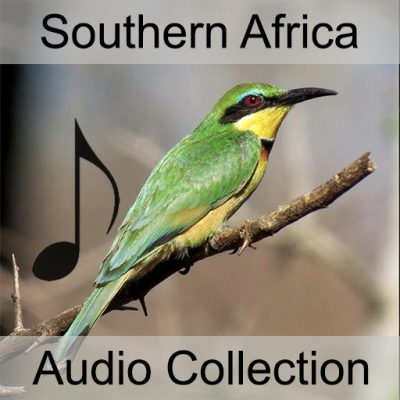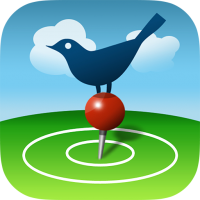Product Description
Intro text from Peter Boesman.
Sound recording of bird voices has been a passion of mine for several decades now: my publication of MP3 sound collections for various neotropical countries was quite a pioneering breakthrough at that time, and at present some 26.000 of my recordings are available and playable on-line.
When working recently on a project to analyze birdsounds as a support for taxonomic decisions, I was quite satisfied with the wealth of sound recordings that had become available for the neotropics, but equally so I was surprised by the relative lack of sound recordings from Africa (and Asia to a lesser extent). I therefore decided to focus more on those regions, and in recent years I have visited Southern Africa several times with the primary aim to record as many as possible birdsounds. Such documentation of bird vocalizations definitely is important, as can be illustrated by e.g. the case of the Cape Parrot, where my recordings sure had an influence on BirdLife’s decision in 2017 to accept its full species status (and with the potential positive consequences for its protection).
With the availability of a few major sound collections of Southern Africa on one hand, and birdsound databases on internet (Xeno Canto, Macaulay) at the other hand, one may wonder if it is still useful to publish an additional sound collection. There are however still many reasons to do so. The internet sources are databases of unselected and unprocessed data, which may be overwhelming for anyone wanting to quickly pick the most representative recordings for a given species. The commercial sound collections at the other hand, typically hold a single example of the song for any bird species, and thus hardly illustrate the variation in voice.
I therefore hope that this new sound collection made with contemporary digital equipment (and mostly in stereo) is a welcome addition and will help birders and scientists in many ways.
Acknowledgements
I am very grateful to the contributing recordists who made it possible to increase the comprehensiveness of this work. In alphabetic order they are Thijs Fijen, Hans Matheve, Faansie Peacock, Niall Perrins, Lynette Rudman and Derek Solomon.
My life-long birding friends Carl Beel, Luc Bekaert, Geert Claeys, Mark Reygaert and Mark Van Beirs accompanied me in the field on some of my birding trips to the region.
By posting my recordings on www.xeno-canto.org I received some much appreciated help with the identification of several unidentified recordings, in particular from James Bradley.
About the Author
Peter Boesman started birding in his home country Belgium in the 70s when he was twelve. He quickly started travelling all over Europe as a backpacker to learn more about the birds of the old continent. At home he made his knowledge at use by guiding nature walks, writing articles, and taking up responsibilities in the birder’s community. He was e.g. member of the Belgian Rarities Committee and co-author of the Avifauna of Flanders.
Parallel to his studies and interest for nature, Peter also studied music, and obtained the Belgian government medal for piano and a First prize at the Royal Conservatory of Ghent (presently called a Master in Music) before he was even eighteen years old ! Whether this early interest in music developed his abilities for working with bird sounds much later in his life will remain an open question.
In the eighties he started travelling beyond Europe: Africa, Asia, the Middle-East, USA and in 1988, he visited Venezuela, his first neotropical experience.
Only 2 years later, a managerial job opportunity offered by a Belgian multinational company made him move to Venezuela, which allowed him in his free time to get better acquainted with the local avifauna. It was also an opportunity to visit neighboring neotropical countries. Peter made soon several discoveries in Venezuela, and published articles about them (he was involved in the re-discovery of e.g. Grey-headed Warbler, Rustyflanked Crake, Great Antpitta, Plain-flanked Rail and he put some new birding places on the map such as Caño Colorado in E Venezuela, now a standard stop on many birding tours).
It is in this period that he also got interested in recording bird vocalizations. There was hardly anything available about Venezuelan birds and it became quickly obvious that knowing bird songs was essential to study birds in the neotropics. Armed with a directional microphone and a tape recorder he went off in the field. This was the start of the creation of his present birdsound collection. Soon he made many unique recordings, not only in Venezuela, but also in other neotropical countries, e.g. in Colombia in 1994 (a time in which hardly any foreign birder visited this country due to the country-wide guerrilla activities) he made the first recordings of a Screech Owl in the Santa Marta region, now described as a new taxon and new species, and in the same region he recorded the Foliagegleaner which was elevated to species rank some 15 years later as Santa Marta Foliagegleaner based on voice!
In 1995, while birding in Peru, an accident involving a Bushmaster snake had near-fatal consequences. Peter miraculously survived, but lost his complete right leg. Less than a year later however, he made his first attempts to get back in the field, he continued recording bird vocalizations and did several bird-censuses of areas in NW Venezuela.
Later he moved to the USA for his job, where he published a pioneering CD-ROM ‘Birds of Venezuela, photographs, sounds and distributions’ (1999). From his new base, it didn’t take him long to venture into the northern side of the neotropics: Mexico. Even when the job called him back to Belgium, he continued travelling to Mexico, and after some years he had not only visited most corners of this magnificent country, but gathered a vast collection of bird song recordings. In the same way, he could not resist the tempting treasure of birds in Brazil.
At the end of 2005, he again came up with a pioneering idea to publish a large set of bird song recordings on a single MP3 CD per country, for Brazil, Mexico and Venezuela, the start of his famous set of ‘MP3 sound collections’.
Back in Belgium, he decided it was time also for this region to have some fresh new recordings (surprisingly, very little had been published of his home country in recent decades!). He acquired the latest digital recording equipment and visited all corners of Belgium and the Netherlands. A few years later, Peter could again deliver, this time an incredible MP3 multimedia fieldguide of the birds of Belgium and the Netherlands. The novelty not only being the excellent sound recordings, but also the unique combination of sound, pictures, distribution maps and text in a format useable on both PC/Mac and MP3 players. His latest achievements in the neotropics rightly deserve the term ‘monumental’. In 2009, for the first time the vocalizations of Peru were documented in a single work (containing no less than 3350 recordings of some 1530 Peruvian bird species). In a similar way he documented the birds of Costa Rica. Then came the update for Brazil and Venezuela (in which no less than 4600 resp. 4200 recordings are included), and his last work in the Neotropics treated Colombia with a staggering 5575 recordings of 1644 species. An amazing coverage of the Neotropics !
Besides publishing birdsound collections, Peter is also transferring his experience in other ways, and since the ‘Handbook of the Birds of the World’ has gone on-line, Peter is an editor for HBW Alive, focusing on the voice section for all bird species. He also wrote Ornithological Notes about vocal differences for some 400 (!) species to support the renewed HBW/Birdlife taxonomy.
Through the years, Peter has accumulated a bird sound collection of some 28000 recordings, almost all of which are now available on the internet. He has published vocalizations of more bird species than anyone in the world by now, despite his serious physical handicap! He hopes to continue doing so in the future, with more focus however on the Old World.
HOW SOUND PACKAGES WORK IN BIRDSEYE
Purchasing this package gives you access to a large collection of bird sounds, all within BirdsEye. It also gives you access to the BirdsEye images and text, as well as the eBird data available for the species that are included in the package.
You can download it to your phone for offline use and remove it to free up space as often as you wish. You can access this package on your iPhone, iPod Touch and iPad, so long as they are all registered to your BirdsEye account. To download all of the sounds for offline use, just go to “Settings” and then choose “Download for Offline”. Enjoy!



